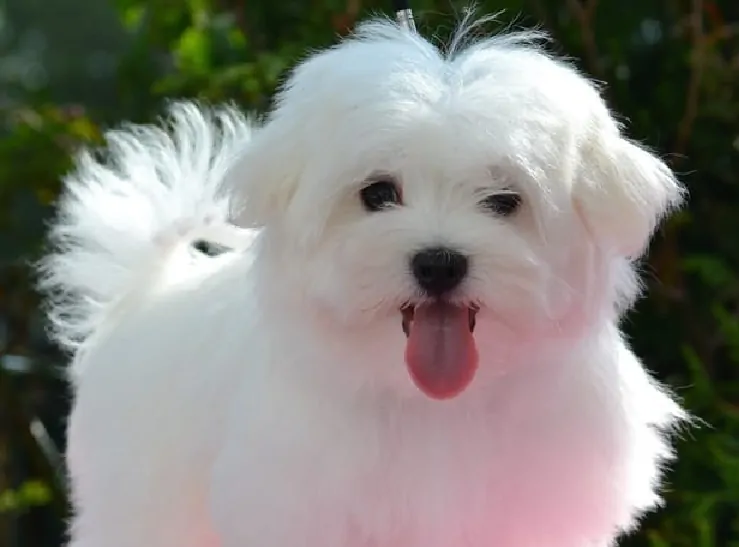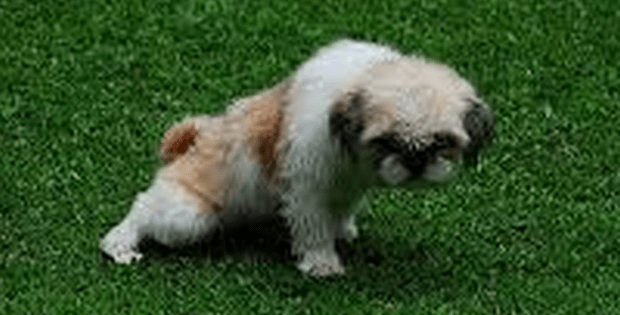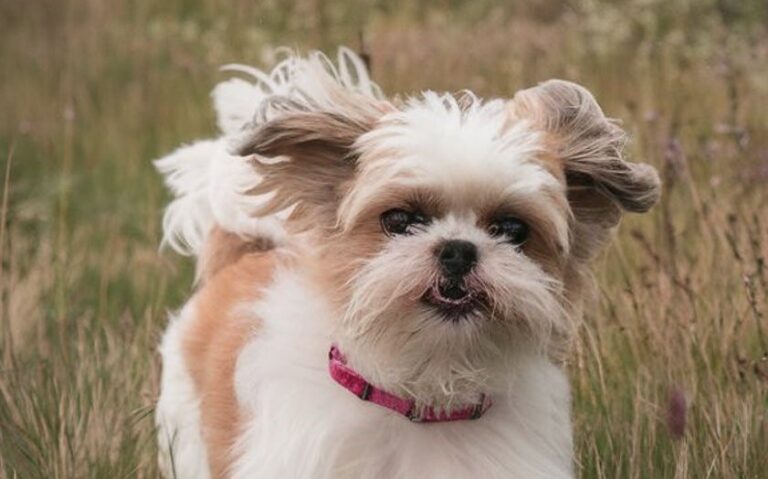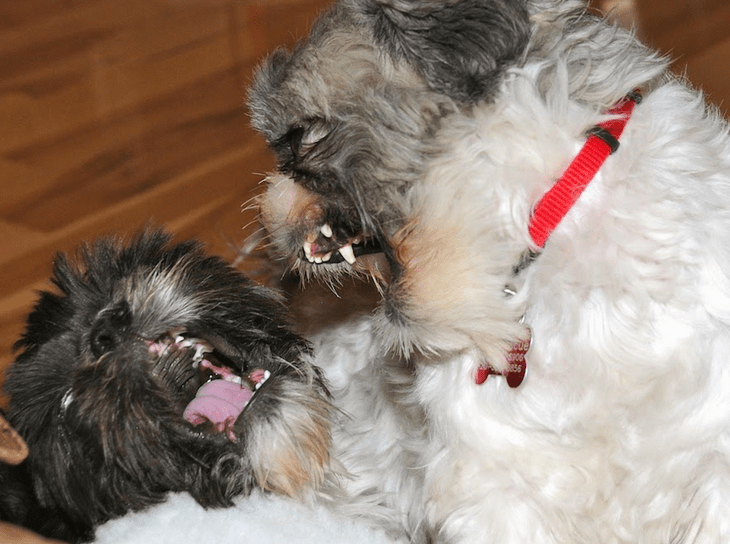Life With Your Tiny Emperor: Navigating Shih Tzu Dominance Like a Pro
I still remember the day I brought Luna home – this fluffy 8-week-old bundle who looked like she belonged on a greeting card.
Fast forward two hours, and she was reorganizing my living room to her specifications!
Seven years later, I’m still amazed at how something so small can have such a HUGE personality.
If you’ve ever found yourself negotiating with a 12-pound dog about who actually owns the couch (spoiler alert: they think they do), you’re in the right place.
Through countless standoffs, dramatic sighs, and those unmistakable “you work for ME” looks, I’ve learned that what we call Shih Tzu dominance, is actually a fascinating mix of their royal heritage, natural confidence, and our own (sometimes unintentional) encouragement.
This isn’t about “breaking their spirit” or showing them “who’s boss” – it’s about creating harmony where both you AND your imperial companion can thrive.
Looking back I think I’ve made every mistake possible!
From embarrassing public displays of defiance to midnight bed-territory disputes, Luna and I have navigated it all, and I’m sharing our hard-won wisdom.
With a little understanding and a lot of consistent love, you can build a relationship where you both feel respected – even if one of you still occasionally wears a topknot and demands to be carried!
Table of Contents
- Hey, What’s Behind That Mighty Personality?
- Training Your Little Boss (Without Drama!)
- My Stuff, Your Stuff (But Really, All My Stuff!)
- Space Invaders (The Shih Tzu Edition)
- Playing Nice (Or Not!) With Others
- Look at Me! – The Attention Seeker’s Guide
- Beauty Queen/King Problems
- Congratulations, You’re Officially Trained (By Your Shih Tzu) – Wrapping Up the Saga
Hey, What’s Behind That Mighty Personality?
Nobody warned me that 12 pounds of fluff could contain so much attitude!

Those first few weeks were eye-opening, watching my tiny newcomer strut around the house like she was inspecting her new kingdom.
After years of living with this adorable dictator (and consulting with countless other Shih Tzu parents facing the same challenges), I’ve come to understand that what we often label as “dominance” in these dogs has fascinating roots.
Their royal Chinese heritage, their historical purpose as companion dogs to emperors, and their natural confidence all blend together to create that unmistakable Shih Tzu personality.
Before we can address specific behaviors, it helps to understand the “why” behind that mighty presence in such a small package.
Let me share what I’ve learned about the psychology behind Luna’s queenly demeanor, and how recognizing these traits has transformed our relationship.
Big Dog Energy in a Small Package – Understanding Small Dog Syndrome
I remember it all too well, watching our tiny fluffball trying to boss around a German Shepherd at the park!
It’s both hilarious and nerve-wracking, right?

But here’s the thing: what we often call “Small Dog Syndrome” isn’t actually your Shih Tzu being naughty.
They’re just… confident. Maybe a little too confident!
Here’s what I’ve learned works wonders:
- Treat them like a dog, not a baby. I know those eyes are irresistible, but your tiny friend needs boundaries just like any other pup!
- When my Mochi started showing his “big dog” attitude, I started having him work for attention. Simple stuff, like sitting before meals or waiting for permission to jump on the couch. Game-changer!
- Remember: confidence is great, but overconfidence can be dangerous. I always tell my Shih Tzu friends that it’s our job to keep these brave little souls safe from their own “I can take on the world” attitude.
My tip: Treat them like a dog, not a baby. Set consistent boundaries while giving plenty of positive reinforcement when they show balanced behavior. This helps them develop appropriate confidence without the “Napoleon complex” that can make small dogs challenging.
Fearless and Fabulous – When Your Tiny Friend Thinks They’re a Lion

Oh boy, can these little ones be fearless!
My Luna once tried to “protect” me from a lawn statue – yes, really!
While their bravery is adorable, it’s important to channel it properly.
You know that thing where they stand super tall and proud, chest puffed out like they’re about to address their kingdom?
That’s your cue to redirect their attention before they decide to “rule” over something (or someone) they shouldn’t!
What’s worked in my experience:
- Create safe challenges that let them feel brave without putting them at risk. Puzzle toys are perfect for this!
- When your pup shows appropriate caution, reward it! I made a big fuss when Sophie finally learned to check with me before approaching new things.
- Never scold them for being protective – instead, teach them when protection isn’t needed. A simple “thank you, but we’re safe” in a calm voice works wonders.
My tip: Channel their natural bravery into appropriate challenges like puzzle toys and training games rather than letting them test themselves against genuinely dangerous situations. A Shih Tzu’s courage often exceeds their physical capabilities!
Quick Reality Check: The Difference Between Shih Tzu Confidence and Shih Tzu Dominance
What looks like dominance in Shih Tzus is often just confidence mixed with their natural royal heritage.
These dogs were literally bred to be companions to Chinese emperors – no wonder they sometimes act like they’re wearing tiny crowns!

A confident Shih Tzu is a joy to have.
They’re adaptable, friendly, and ready for adventure.
A dominant one can be challenging. The key is knowing the difference:
- Shih Tzu confidence means they’re happy to follow your lead but aren’t afraid to explore
- Shih Tzu dominance is when they insist on making ALL the decisions (and trust me, a Shih Tzu-ruled household is chaos!)
My tip:
Training Your Little Boss (Without Drama!)
After more than a decade of living with Shih Tzus and helping countless friends with their own tiny emperors, I’ve learned one universal truth: training these adorable dictators is an art form that requires equal parts patience, humor, and creativity.
What changed everything for me was the moment I stopped treating training as a series of commands and started seeing it as a dance with a very opinionated partner.
Try it too; this perspective shift will save your sanity!
Did They Just Roll Their Eyes at Me? – Working Through Command Stubbornness
Do you remember the first time your Shih Tzu gave you that look?

You know the one I’m talking about – that perfect mixture of “I heard you” and “I’m choosing to ignore you.”
My Luna was the queen of this expression.
One memorable afternoon, I spent 15 minutes asking her to “come” while she sat just out of reach, tilting her head as if to say, “That’s a fascinating suggestion, but I have other plans.”
The breakthrough came when I realized Luna wasn’t being stubborn – she was waiting for me to make it worth her while.
Not just with treats (though they help!), but with enthusiasm and engagement.
Now, when I call her, I make it sound like the most exciting invitation she’s ever received.
Sometimes I still get the head tilt, but now it’s usually followed by a happy trot in my direction.
My tip: Keep training sessions short, upbeat, and unpredictable. The moment your Shih Tzu thinks they can predict your pattern, they’ll decide whether it’s worth their participation. Keep them guessing with varied rewards and training locations.
But I Don’t Wanna! – Making Training Fun for Your Stubborn Friend
Let me tell you about the Great Training Standoff.
There I was, armed with premium treats and unwavering determination, trying to teach Luna to “stay.”
She had other ideas.
For weeks, every training session ended with her dramatically flopping over or wandering off to groom herself – the Shih Tzu equivalent of saying “talk to the paw.”

The game-changer?
Turning training into playtime.
Instead of formal sessions, I started incorporating commands into our daily fun.
“Stay” became part of hide-and-seek.
“Come” turned into a chase game (with me being the one running away).
Suddenly, my little diva was learning without even realizing it!
My tip: Turn “no” into “let’s try something different.” When your Shih Tzu refuses a command, switch immediately to one they enjoy before returning to the challenging one. This prevents standoffs while maintaining your leadership position.
I’m Walking YOU! – Leash Adventures with Your Tiny Leader
Picture this: a tiny 12-pound fluff ball pulling so hard she’s walking on her back legs, determined to inspect every single leaf on our path.
That was our first month of walks with Luna.
I felt like I was being dragged around by the world’s smallest sled dog!

The turning point came during one particularly memorable walk when Luna decided to play anchor instead of sled dog – just sat down and refused to move.
Right there, in the middle of the sidewalk, we had our moment of mutual understanding.
She taught me that walks aren’t just about exercise; they’re about exploration and bonding.
Once I started giving her time to sniff and explore (within reason), the pulling magically decreased.
My tip: Invest in a properly fitted harness rather than a collar for walking. This gives you better control without the neck strain that can make some Shih Tzus even more resistant to leash guidance.
The Crate Escape Artist – Making Their Space Feel Like Home

Luna had some great crate escape attempts!
She treated her crate like a puzzle to be solved, and for a while, she was winning.
The final straw was finding her somehow wedged between the crate and the wall, looking mighty pleased with herself.
What finally worked wasn’t any fancy technique – it was understanding that my little princess needed her space to feel like a palace.
I transformed her crate from a simple box into her personal retreat, complete with her favorite plush blanket and a view of the room.
Now she trots in there on her own when she needs some “me time,” though she still expects me to pretend I don’t notice her sneaking in!
My tip: Never use the crate as punishment, and always make it more comfortable than any other sleeping spot in your home. When they choose to go there on their own, they’re telling you they feel safe—the ultimate compliment from a Shih Tzu!
My Stuff, Your Stuff (But Really, All My Stuff!)
If there’s one thing I’ve learned from years with these fluffy little controllers, it’s that Shih Tzus have a very… flexible understanding of ownership.
Basically, everything is theirs—they’re just graciously allowing you to borrow it!
My Luna once staged a sit-in protest on my laptop when I was working from home, giving me a look that clearly said, “Excuse me, but I believe you’re using MY typing surface.”
After countless standoffs over toys, beds, and yes, even my own pillow, I’ve gathered some wisdom about navigating the complex territory laws of Shih Tzu Land.
Hands Off My Treasures! – Dealing with the Protective Pup
The first time Luna growled at me for reaching toward her new chew toy, I was honestly shocked.

This sweet-faced angel who demanded belly rubs had suddenly transformed into a tiny dragon guarding her hoard! It felt personal until I realized it wasn’t about me at all—it was about her sense of security.
Working through this was a journey of patience.
I started by trading up—offering something even better when I needed to take something away.
Soon, Luna learned that giving up a treasure usually meant getting something even more exciting.
The growling stopped, replaced by an expectant look that said, “Okay, what’s the upgrade?”
Sometimes prevention is better than training.
I noticed Luna was most protective of things she’d had for a while undisturbed, so I started a rotation system for her toys.
This kept everything fresh and reduced her attachment to any single item.
My tip: When your Shih Tzu starts resource guarding, resist the urge to scold. Instead, become the bearer of even better gifts. Always trade up, never just take away. Your relationship (and fingers) will thank you!
The Dinnertime Diva – Creating Happy Mealtimes
Mealtime with Luna used to be… dramatic.
She’d dance around her bowl, bark if I got too close, and occasionally give me side-eye worthy of a teenager.
If you’ve ever felt judged by a dog over dinner arrangements, you might have a Shih Tzu!
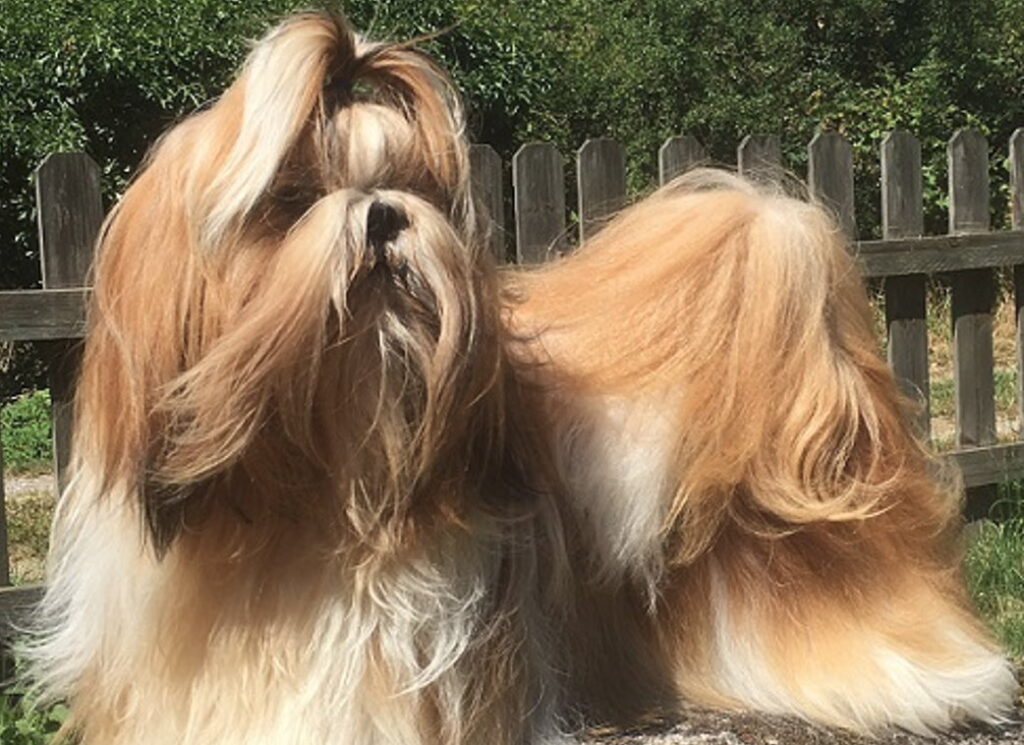
The breakthrough came when I established a pre-meal routine.
Luna now sits and waits while I prepare her food, and she doesn’t approach until I give permission.
This simple change transformed our dynamic from “servant feeding royalty” to “leader providing for pack member.”
One particularly memorable evening, Luna decided mid-meal that she needed to guard her food from the dangerous threat of… a paper bag that had fallen over.
I used this as a teaching moment, calmly removing the “threat” while talking soothingly. These little wins add up!
My tip: Hand-feeding your Shih Tzu occasionally works wonders for food guarding. Start with just a few pieces from their regular meal, and they’ll associate your hands near their food with good things, not competition.
That’s MY Toy! – Sharing is Caring
Luna’s toy collection rivals that of some small toy stores.
Despite having dozens of options, she would fixate on one particular squeaky bird for weeks, carrying it everywhere and growling if anyone approached.
Teaching her to share wasn’t just about manners—it was survival when we had guests!

I introduced the “trade and return” game, where I’d offer a treat in exchange for her toy, then give the toy right back.
This taught her that sharing didn’t mean permanent loss.
The day she voluntarily dropped her precious bird at my feet, looking up expectantly for our trading game, I nearly cried with pride.
My tip: Never chase your Shih Tzu to get a toy back—that just turns it into a high-value prize. Instead, be boring about toys they’re guarding while making shared toys incredibly fun. They’ll start bringing toys TO you instead of running away!
The Couch Potato Boss – Furniture Claiming 101
One day I returned from a quick grocery run to find Luna sprawled across my favorite reading chair, giving me a look that clearly said, “Yes? Can I help you?”
This little 12-pound fluff had somehow claimed a full-sized armchair as her exclusive territory!

Rather than fighting this battle directly, I created even more appealing spots nearby—a plush dog bed with her favorite blanket positioned so she could still see everything happening.
The chair gradually lost its appeal when the alternative was even cozier.
For spaces we needed to share, I established gentle boundaries.
Luna learned that she could join me on furniture, but only when invited.
This preserved her dignity while maintaining household order.
My tip: If your Shih Tzu has claimed your favorite spot, don’t physically remove them (unless absolutely necessary). Instead, create an irresistible alternative nearby and use a command like “place” to direct them there with positive reinforcement.
This Spot is Mine! – Navigating Furniture Battles
There’s nothing quite like the experience of being edged off your own couch by a dog that weighs less than your winter boots.
Luna’s technique was masterful—she’d start at the far end, then gradually stretch, reposition, and somehow end up taking the entire space while I found myself perched on the edge!
I implemented the “move over” command, paired with gentle guidance and treats.

Now when I say “move over,” Luna shifts to make room without drama.
Sometimes she sighs dramatically, but she does it!
Remember that notorious Shih Tzu stubbornness?
I discovered it has a weakness: consistent, gentle persistence.
The key was never making it a power struggle, but presenting it as a mutual agreement.
My tip: Establish furniture rules early and stick to them consistently. Whether you choose “no furniture” or “only when invited,” the consistency matters more than the actual rule. And always provide a nearby alternative that’s just as comfortable!
The Bedroom Bouncer – When Your Pup Guards Their Sleeping Spot
The first night Luna growled at my husband when he tried to get into bed was both amusing and concerning.
This tiny dog had appointed herself guardian of the bed, and apparently, my husband hadn’t received proper clearance!
We addressed this by temporarily restricting bed access, then reintroducing it with clear rules.
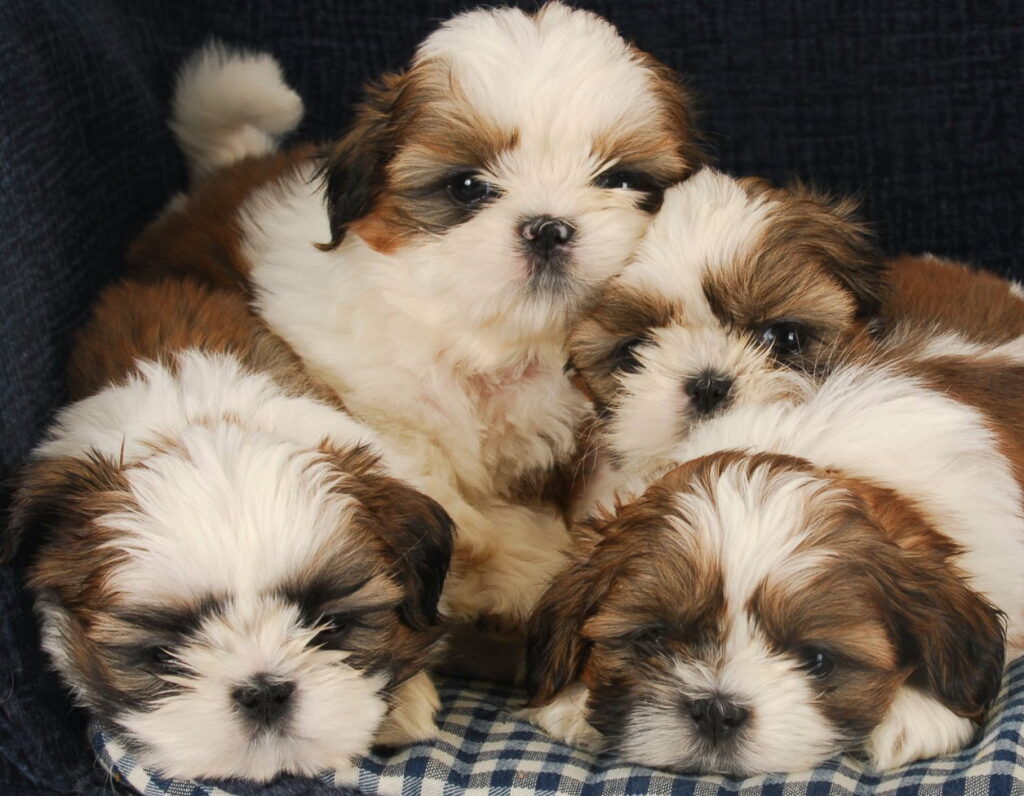
Both humans get in bed first, then Luna is invited up.
This simple change in routine completely eliminated the guarding behavior.
I also noticed Luna was most protective when she was overtired—just like a cranky toddler!
Making sure she had enough exercise and mental stimulation during the day led to much more relaxed evenings.
My tip: If your Shih Tzu guards sleeping areas, create a designated sleeping spot for them that’s still close to you but not right between you and your partner. A small bed or cushion at the foot of your bed can work wonders for maintaining peace!
Space Invaders (The Shih Tzu Edition)
As a Shih Tzu owner, you know they have some… interesting ideas about personal space – namely, that it doesn’t exist!
Despite their small size, these fluffy companions somehow manage to take up enormous amounts of territory, both physical and emotional.
After years of navigating Luna’s spatial demands, I’ve learned that what looks like dominance is often just their royal heritage showing through.
These dogs were bred to be imperial companions, after all!
Let me share some tales from the trenches of territorial training that might save you some cleanup and neighborly apologies.
Oops, I Did It Again – Understanding Indoor Marking
Picture this: You’ve just had your carpets professionally cleaned, your house smells amazing, and suddenly your perfectly potty-trained Shih Tzu decides to leave a “little message” on your favorite rug.

The first time Luna did this, I was convinced she was angry at me for something.
Turns out, she was just asserting her status in our home after a new dog had visited earlier that day.
Indoor marking is rarely about bathroom needs – it’s communication!
Luna was essentially posting a “Property of Luna” sign.
Once I understood this, addressing it became much easier.
I deep-cleaned marked areas with enzymatic cleaners and temporarily limited her access to previous marking spots.
The most effective solution came from reinforcing her position in our “pack” through positive interactions.
Daily training sessions, structured meal times, and consistent rules helped her feel secure without needing to leave reminders around the house.
My tip: If your Shih Tzu suddenly starts marking indoors, don’t just clean it up – play detective! New furniture? New pet? New routine? Find the trigger and address that, not just the symptom. And remember, veterinary check-ups are essential to rule out medical issues before assuming it’s behavioral.
Me First! – The Door-Rushing Drama
Luna’s door manners used to be… non-existent.
The moment I reached for the doorknob, she’d transform into a furry missile, determined to be first through any opening.

This wasn’t just annoying – it was potentially dangerous, especially at front doors.
Our breakthrough came from the “wait” command paired with unbelievable patience (mine, not hers).
I’d stand at the door, hand on knob, and wait for her to back up and sit.
In the beginning, we sometimes stood there for what felt like hours, engaged in a battle of wills that my little 12-pound general was determined to win.
One particularly memorable standoff ended when Luna dramatically flopped onto her side with a sigh, as if to say, “Fine, you win this round.”
I celebrated that tiny surrender like we’d won the lottery! Small victories add up.
My tip: Create a “door spot” – a small mat or marked area where your Shih Tzu must sit before any door opens. Practice this routine when you’re not actually going anywhere to remove the excitement factor. The investment in training time will pay off in safety and sanity!
Personal Space? What’s That? – Teaching Your Pup to Share Spaces
The concept of personal space is utterly foreign to most Shih Tzus.
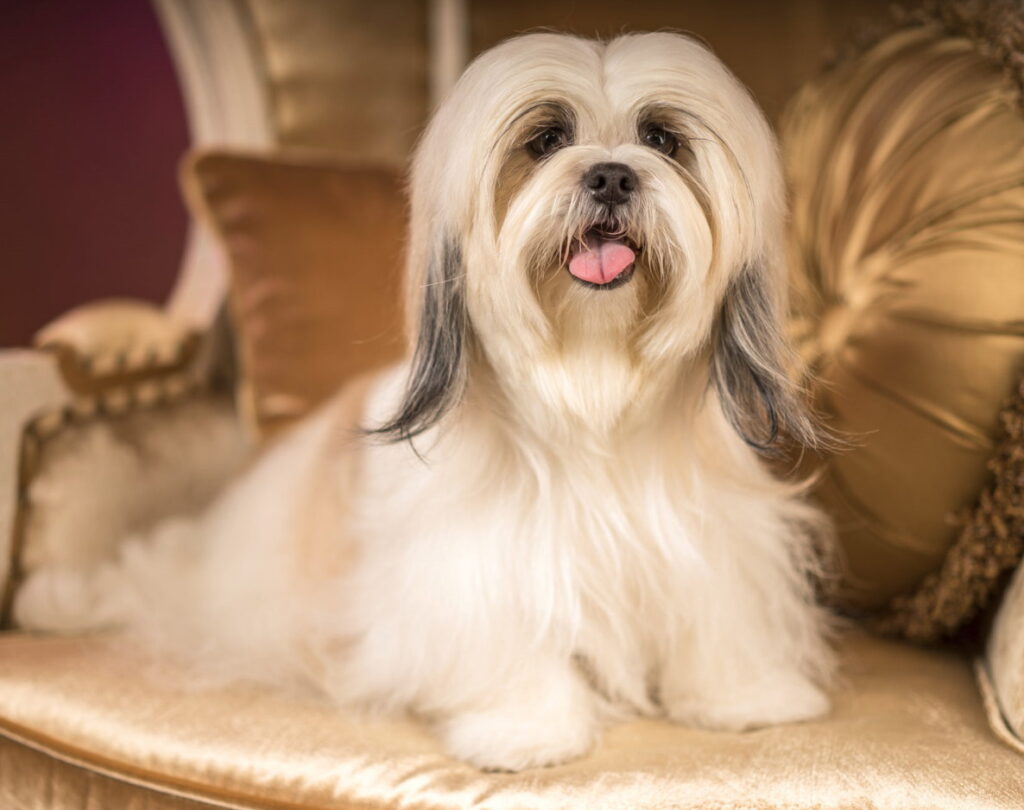
Luna follows me into the bathroom, sleeps pressed against me despite having an entire king-sized bed, and once attempted to join me in the shower (that didn’t end well for either of us).
Rather than fighting this inherent velcro-dog tendency, I established “invitation only” zones.
Luna learned that certain areas required permission, while others were always accessible to her.
This compromise preserved my sanity while respecting her need for closeness.
The funniest moment in our space-sharing journey came when guests visited.
Luna would position herself strategically between me and any visitor, occasionally giving them a look that clearly said, “You may speak to my human, but maintain appropriate distance.”
My tiny, fluffy bodyguard!
Teaching Luna to respect others’ space was a gradual process of gentle redirection and positive reinforcement.
When she crowded visitors, I’d call her to a nearby spot and reward her for staying there.
Eventually, she learned that respecting space resulted in more attention and treats than invading it.
My tip: Create special “close but not touching” spots near places where you need space. A small bed near your desk, a cushion by the dining table, or a mat near the kitchen can give your Shih Tzu the proximity they crave while maintaining boundaries you need.
Playing Nice (Or Not!) With Others
Shih Tzus and their… unique approach to social interactions.
After watching Luna navigate countless dog parks, family gatherings, and playdates, I’ve come to one conclusion: Shih Tzus don’t just think they’re people – they think they’re the MOST IMPORTANT people in any room!

This breed’s imperial history shines through in how they interact with others, whether human or canine.
While some might call it “bossy,” I prefer “naturally directive.”
Understanding this social confidence has been key to helping Luna build healthy relationships instead of tiny tyrannies.
Let me share some stories from our social adventures together!
The Protective Bodyguard – When Your Pup Gets Too Clingy
The first time my friend Sarah tried to hug me goodbye, Luna wedged herself between us with a look that clearly said, “Excuse me, this human is MINE.”
I was equal parts embarrassed and amused at my tiny defender’s determination.
Luna had appointed herself my personal bodyguard, complete with suspicious glares for anyone who came too close.
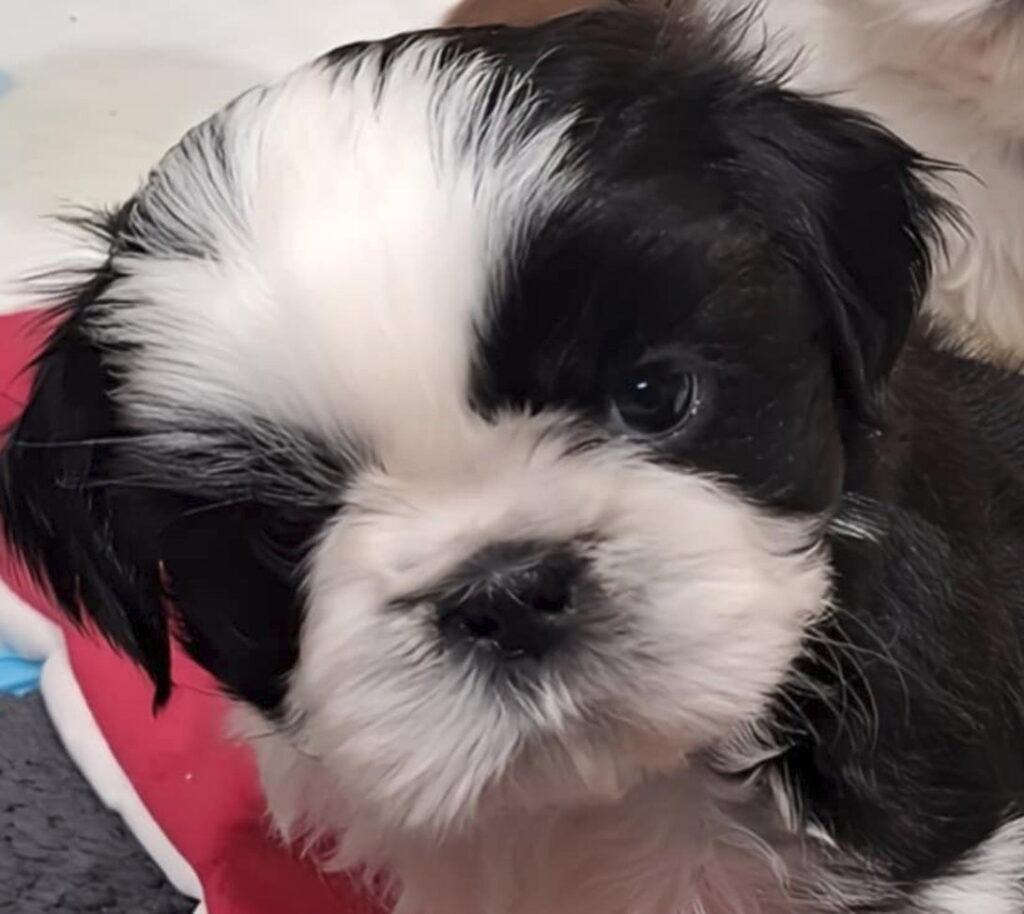
While it seemed cute at first, I realized this possessive behavior needed addressing when Luna started growling at my husband if he sat next to me on the couch.
Not exactly conducive to marital harmony!
The turning point came when I started rewarding Luna for calm behavior when others approached me.
Instead of reinforcing her “protection” by picking her up or soothing her, I’d ask visitors to toss treats to her while keeping a respectful distance.
Gradually, people approaching became a positive experience rather than a threat.
My most successful strategy was teaching Luna a “place” command – a designated spot where she could watch interactions but not interfere.
This gave her the security of monitoring situations without the stress of feeling she needed to control them.
My tip: If your Shih Tzu gets overly protective, resist the urge to pick them up or soothe them, as this reinforces their belief that there’s something to be concerned about. Instead, create positive associations with people approaching by having visitors offer treats without direct interaction until your pup is comfortable.
Top Dog Wannabe – Understanding Mounting Behavior
Oh boy, this is an awkward one!
The day Luna decided to assert her dominance over my neighbor’s much larger Golden Retriever by attempting to mount him was… memorable.
There I was, mortified, watching my 12-pound fluffball trying to establish herself as pack leader over a dog four times her size.
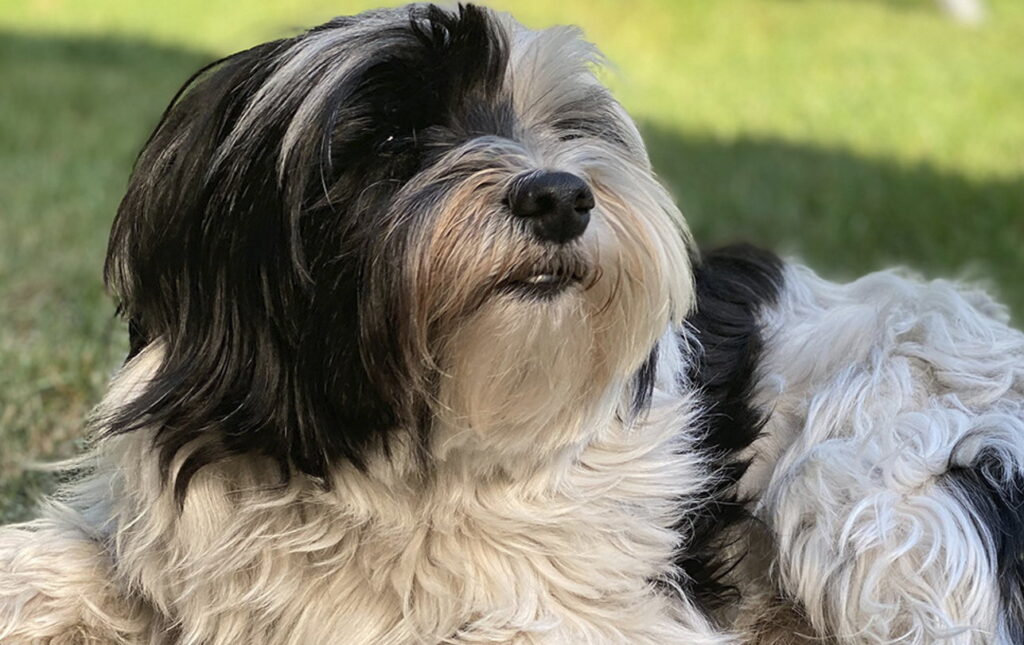
This behavior wasn’t sexual – it was purely about status.
Luna was essentially saying, “I’m the boss here!”
The Golden, bless his heart, just looked confused by the tiny dictator on his back.
After consulting with our trainer, I learned to watch for the signs leading up to mounting behavior.
Luna would get a certain look in her eye, her posture would stiffen, and she’d start positioning herself.
By intercepting before the behavior started and redirecting her to appropriate activities, we reduced incidents significantly.
We also worked on alternative ways for Luna to feel confident, like mastering new tricks and having structured playtime where she felt in control without resorting to mounting.
My tip: If your Shih Tzu is a “mounter,” carry a favorite squeaky toy during playdates. When you see the behavior starting, redirect with the toy to give them an appropriate outlet for their energy and a positive way to engage with other dogs.
Small But Mighty – Managing Dog Park Drama
One of Luna’s dog park visit was eye-opening.

While other small breeds clustered together, my fearless girl marched straight up to a Mastiff and barked orders at him like she was conducting an orchestra.
The Mastiff, thankfully, had a good sense of humor about being bossed around by a dog the size of his head.
Not all big dogs are so understanding, though.
I quickly learned that Luna needed guidance on appropriate inter-dog etiquette.
We started with controlled playdates with known, balanced dogs who could communicate boundaries without aggression.
I also discovered that Luna’s bossiness increased when she was overstimulated.
Limiting dog park visits to 30 minutes and taking “cool down” breaks helped her maintain better social skills.
The “recall and reward” technique became our best friend.
Before Luna could escalate bossy behavior, I’d call her back to me, reward her, and then release her to play again.
This created natural breaks in her intensity and reinforced that checking in with me was worthwhile.
My tip: Find dog friends whose play style matches your Shih Tzu’s energy level. Luna plays best with confident but gentle larger dogs who aren’t intimidated by her bossiness but won’t respond aggressively. Knowing your dog’s “type” can prevent many social mishaps!
Not the Kids! – Creating Safe Spaces with Children
The day my niece came to visit was when I saw a new side of Luna.
My usually social butterfly suddenly became withdrawn and growly when my energetic 5-year-old niece tried to pet her.
It wasn’t aggression – it was anxiety.

Luna had rarely been around children, and their unpredictable movements and high-pitched voices were overwhelming.
Rather than forcing interactions, I created safe spaces where Luna could observe without being touched.
We taught my niece to toss treats toward Luna without approaching her, allowing Luna to associate children with positive experiences from a comfortable distance.
Over several visits, using lots of treats and patient guidance, Luna gradually began approaching my niece voluntarily.
The first time she laid her head on my niece’s lap for a pet was a breakthrough moment that had me quietly wiping away tears of pride.
The key was respecting Luna’s boundaries while creating structured, positive exposure to children.
Never forcing interaction, always providing escape routes, and closely supervising every moment.
My tip: Create a “safe zone” where your Shih Tzu can retreat from children when feeling overwhelmed. Teach children that when the dog is in this space, they are not to be disturbed. This sense of control often helps nervous dogs feel secure enough to eventually seek interaction on their own terms.
Look at Me! – The Attention Seeker’s Guide

If Shih Tzus had a family motto, it would probably be “All eyes on me, please!”
These little companions didn’t spend centuries being adored by Chinese royalty without developing a taste for the spotlight.
My Luna has elevated attention-seeking to an art form – from strategic positioning herself between me and my book to her impressive vocal performances when she feels overlooked.
While it’s adorable (and occasionally exasperating), this need for acknowledgment can become problematic when it turns into demanding behavior.
Through countless theatrical episodes and attention-grabbing antics, I’ve gathered some insights on channeling this desire for spotlight in healthier directions.
The Tiny Town Crier” – Managing Those Big Barks
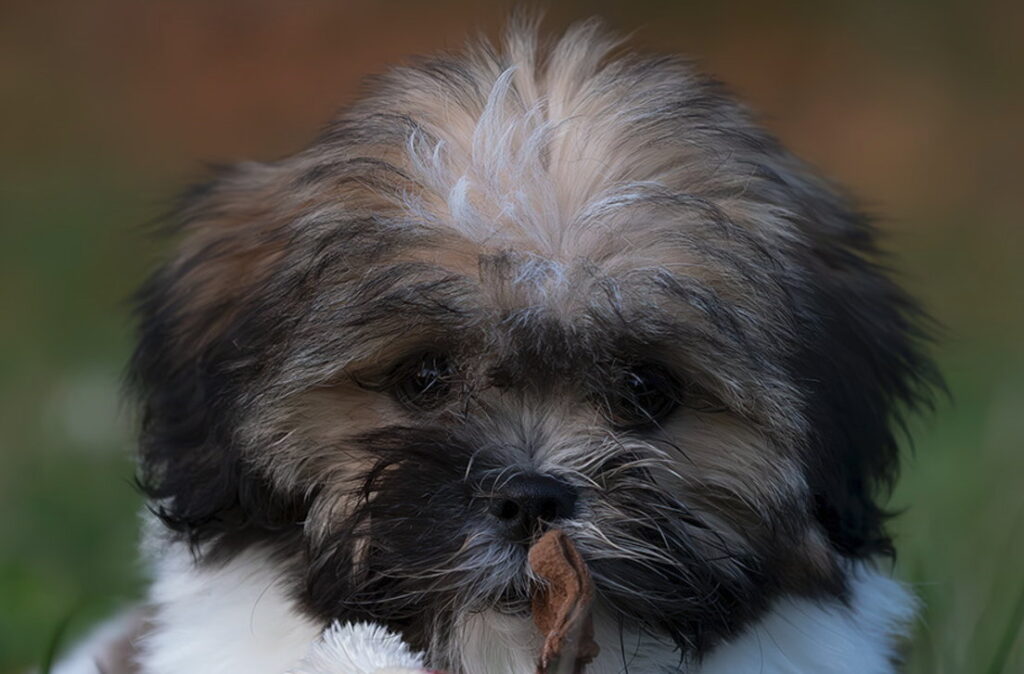
Who knew something so small could be so LOUD?
The first time Luna unleashed her full vocal capacity, my neighbor texted to ask if everything was okay.
The cause of this sonic explosion?
I had the audacity to take a phone call without permitting Luna to sit on my lap during it.
Luna’s “alarm system” had different barks for different demands:
- The sharp, single bark: “Hey, I exist!”
- The repetitive yap sequence: “You’re ignoring me and that’s UNACCEPTABLE!”
- The low grumble-bark: “That’s MY spot you’re sitting in”
The turning point came when I realized I was inadvertently rewarding the barking by rushing to see what she needed.
Even negative attention was still attention!
Instead, I began completely ignoring Luna when she barked for attention, only engaging when she was quiet.
The first few “extinction bursts” (when the barking got worse before getting better) were truly testing, but persistence paid off.
For legitimate barking reasons, I taught Luna a “speak” and “quiet” command.
This gave her an approved way to vocalize and, more importantly, a way to stop on command.
The day she gave a single warning bark at the delivery person and then looked to me for guidance was a proud milestone in our journey.
My tip: If your Shih Tzu has become a vocal attention-demander, start carrying a small container of treats in your pocket. Randomly reward them when they’re being quiet and calm, catching those golden moments of good behavior. Soon they’ll realize that silence, not noise, makes good things happen!
Notice Me Now!” – Handling the Attention-Seeking Superstar

Luna’s repertoire of attention-getting behaviors would put many performers to shame.
My personal favorite was her “fainting spell” – dramatically flopping onto her side with a sigh whenever I was focused on something other than her.
Then she’d peek to see if I noticed, which always gave away the game.
Some of Luna’s classic attention-seeking moves included:
- The strategic toy placement (dropping toys progressively closer to my feet)
- The laptop blockade (positioning herself between me and my screen)
- The pitiful paw (placing one delicate paw on my knee with soulful eyes)
- The hover-dog (standing uncomfortably close, staring, without touching)
Rather than fighting these behaviors, I redirected them.
I established “attention times” throughout the day – dedicated periods where Luna received my undivided focus.
This scheduled approach helped her feel secure that attention would come, reducing her need to demand it constantly.
I also taught Luna an appropriate way to ask for attention – touching her nose to my hand.
This replaced the barking, pawing, and dramatic displays with a single, polite gesture I could either acknowledge or gently rebuff depending on the situation.
Perhaps the most effective strategy was preventing boredom before it led to attention-seeking.
Mental stimulation through puzzle toys, training sessions, and rotating her toy collection kept Luna occupied and less focused on monitoring my every move.
The funniest breakthrough moment came during a work call when Luna brought her puzzle toy over instead of interrupting.
She had finally understood that self-entertainment was an option! I nearly muted my call to cheer.
My tip: Create an “attention station” near where you often work or relax – a comfortable bed with a rotating selection of engaging toys. Whenever your Shih Tzu chooses to use this space instead of demanding your focus, quietly deliver a treat or brief praise. You’re teaching them that excellent things happen when they entertain themselves!
Beauty Queen/King Problems
Shih Tzus weren’t blessed with that gorgeous flowing coat just to be low-maintenance!
These dogs are the beauty pageant contestants of the canine world, and many of them know it.
After many years of grooming battles with Luna, I’ve earned what I call my “unofficial dog cosmetology degree.”
Those adorable show dog photos?
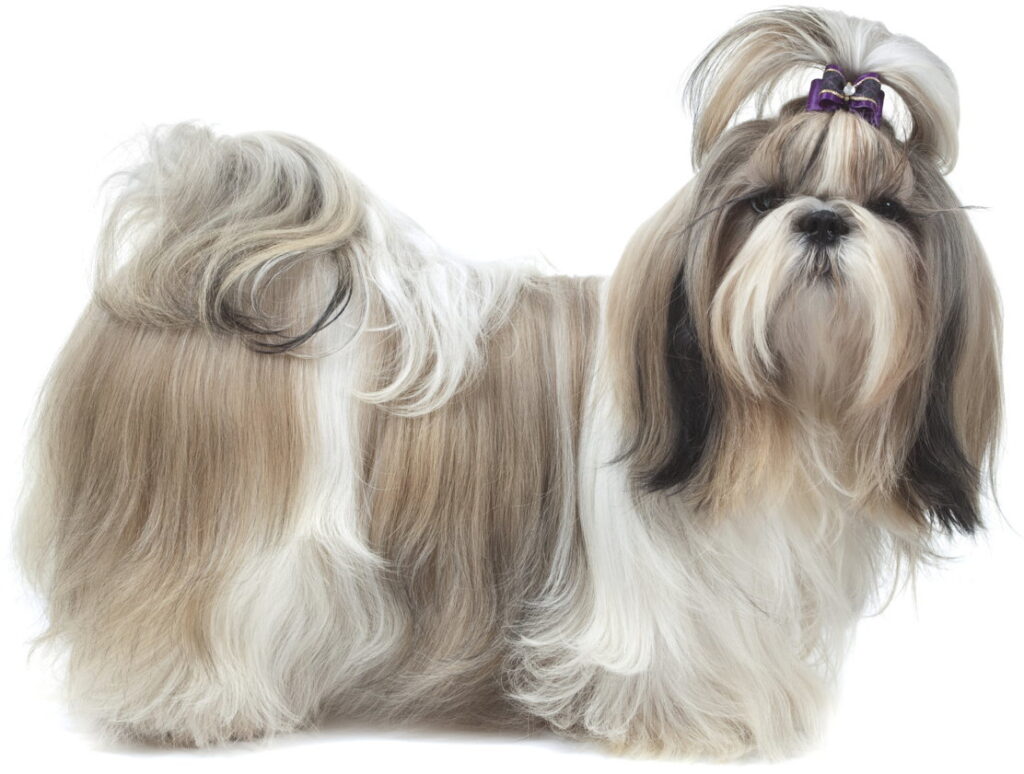
They’re the result of cooperation that most of us Shih Tzu parents can only dream about!
Luna made it very clear early on that while she enjoyed being pretty, she had strong opinions about how that prettiness should be achieved.
Our grooming sessions evolved from what looked like wrestling matches to something more like diplomatic negotiations.
If you’ve ever found yourself pleading with a 12-pound dog to “please, just let me brush this one spot,” then you’re already part of our exclusive club.
Let me share some hard-earned wisdom from the grooming trenches!
Don’t Touch the ‘Do! – Grooming Without the Grumbles
The first time I tried to brush Luna’s gorgeous coat, she looked at me like I had suggested something deeply offensive to her royal dignity.
She didn’t just resist – she performed a remarkable combination of slithering, freezing, and occasionally growling that made basic maintenance nearly impossible.

What transformed our grooming battles into grooming bonding:
- The Treat Timeline – I placed a line of tiny treats on the edge of the grooming table, giving one after each small section was brushed. This turned the experience into a progressive reward system.
- The “Grooming Station” – Creating a consistent location just for grooming helped Luna understand what was happening rather than feeling ambushed by a brush during cuddle time.
- Patience Perfected – I learned that three 5-minute sessions were infinitely more successful than one 15-minute marathon. When Luna started showing signs of stress, we’d take a break rather than pushing through.
Our breakthrough moment came unexpectedly.
After months of careful conditioning, Luna actually brought me a brush after coming in from a particularly windy walk!
She had made the connection that brushing resolved uncomfortable tangles.
I nearly cried with pride (while quickly grabbing the treats before she changed her mind).
My tip: Start handling your Shih Tzu’s sensitive areas (paws, ears, face) during cuddle sessions when they’re relaxed, pairing gentle touching with treats and praise. This separates the physical handling from grooming tools, making the actual grooming much less stressful when it’s time.
The No-Touch Zone – Building Trust with Your Sensitive Friend
Luna had definite opinions about which parts of her body were acceptable to touch.
Paws? Absolutely not.
Ears? How dare you.
Face? Only on her terms.
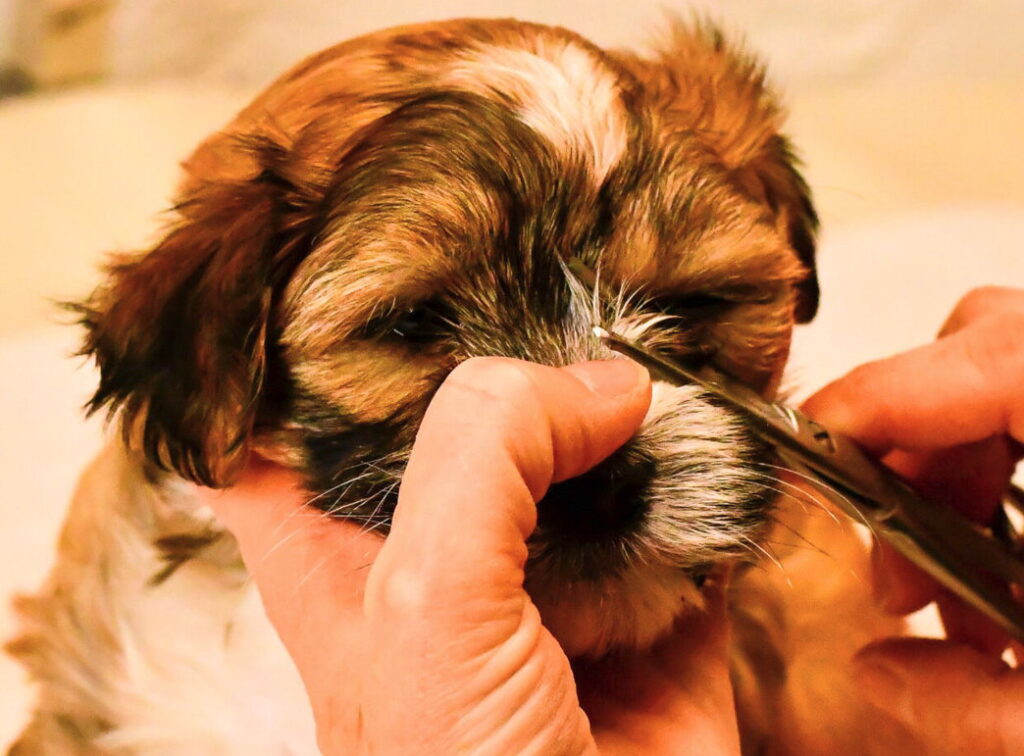
This selective sensitivity made everything from nail trims to ear cleaning feel like I was disarming a tiny, adorable bomb.
After an embarrassing vet visit where Luna dramatically acted like I’d never touched her paws before (despite our practice sessions), I realized we needed a more systematic approach.
The Desensitization Journey that worked for us:
- Day 1-7: Touch a paw, treat immediately. Repeat 5-10 times daily.
- Day 8-14: Hold a paw gently for 2 seconds, treat. Gradually increase holding time.
- Day 15-21: Introduce nail clippers – just set them nearby during paw touching. Treats flow freely!
- Day 22+: Touch clippers to nails without cutting. Progress to trimming one nail, then more.
The most surprising lesson was how much my energy affected Luna’s reaction.
When I approached these sessions with anxiety (expecting resistance), she became tense.
When I remained matter-of-fact and calm, her resistance decreased significantly.
One morning, I found Luna sleeping deeply and managed to clean all four paws without drama.
This “sleepy grooming” became our secret hack for particularly challenging procedures – though I don’t recommend it as a primary strategy!
My tip: Create a “touch chart” where you track your Shih Tzu’s comfort with having different body parts handled. Focus extra desensitization work on their most sensitive areas with daily 30-second sessions. This methodical approach builds confidence much faster than occasional longer sessions.
Salon Day Drama – Making Grooming Great Again

The first professional grooming appointment was… memorable.
I handed over my precious Luna, and picked up what appeared to be a traumatized, trembling puffball two hours later.
The groomer looked equally shaken.
Apparently, Luna had strong opinions about proper grooming protocol that she wasn’t shy about expressing!
Through trial and error (and several apologetic tipping situations), we discovered a better approach.
What transformed our professional grooming experiences:
- The Meet-and-Greet – We started visiting the groomer just for treats and petting, no grooming. This built positive associations with the location.
- The Grooming Assistant – I stayed visible during the first few full sessions, gradually moving further away as Luna’s comfort increased.
- The Consistent Stylist – Finding one patient groomer who understood Luna’s “quirks” was worth its weight in gold.
I’ll never forget the day our groomer called Luna a “pleasure to work with.”
I nearly asked her to repeat it for evidence!
The transformation happened so gradually that I barely noticed the milestones along the way.
For home maintenance between appointments, I discovered that Luna tolerated grooming much better when positioned on a slightly elevated, non-slip surface rather than my lap.
This created a clear distinction between cuddle time and grooming time.
My tip: Create a pre-grooming ritual that helps your Shih Tzu understand what’s coming. For Luna, it’s a specific calming treat followed by a special grooming-only toy that she only sees during brushing sessions. This predictable routine helps them transition mentally into “grooming mode.”
Congratulations, You’re Officially Trained (By Your Shih Tzu) – Wrapping Up the Saga
After years of adventures with Luna, I had a moment of clarity while watching her strategically reposition herself on the couch – moving inch by inch until she had the prime spot while I was squished into the corner.
I wasn’t annoyed; I was impressed.
That’s when it hit me: in many ways, Luna had trained me just as much as I had trained her!

This journey through Shih Tzu dominance isn’t really about “winning” or “being in charge” – it’s about finding that sweet spot where both of you feel respected and understood.
These imperial little companions have a dignity and self-assurance that’s been bred into them for centuries.
Fighting against that natural confidence usually fails, but channeling it constructively creates harmony.
What I’ve discovered through all our trials and tribulations:
- Consistency trumps everything. Luna can predict exactly how I’ll respond to her behaviors, which gives her security even when the answer is “no.”
- Positive reinforcement isn’t just kinder – it’s actually more effective with this breed. My stubborn girl simply shuts down with negative approaches.
- Respect goes both ways. When I acknowledged Luna’s need for choice and dignity, she became far more willing to acknowledge my leadership.
- Pick your battles wisely! Some “dominant” behaviors are just Shih Tzu quirks that don’t actually cause problems. I’ve learned to smile at Luna’s little displays of royalty rather than seeing each one as a challenge.
- Balance is everything. These dogs need both structure AND freedom to thrive. Too much of either creates problems.
My favorite memory comes from a visit from my friend Sarah, who had watched our journey from the beginning.
“I can’t believe this is the same dog,” she said, as Luna politely greeted her without the possessive growling of the past.
“Did you take her to some special training?”
The truth was both simpler and more complex: we had learned to speak each other’s language.
Luna still has her moments of imperial decree, but they come with a subtle look toward me – checking that her confidence is appropriately directed.
And I still provide structure, but with respect for her royal heritage.
If there’s one thing I want you to take away from our story, it’s this: the goal isn’t to squash your Shih Tzu’s mighty personality – it’s to channel it into a relationship where both of you feel valued.
These tiny emperors can be the most loyal, loving companions when they know exactly where they stand and feel secure in their position in your “kingdom.”
My final tip: Take a moment each day to see the world through your Shih Tzu’s eyes. When Luna stands tall, surveys her domain (also known as our backyard), and gives that satisfied little head toss, I see a descendant of imperial companions doing exactly what she was bred to do – carrying herself with dignity and pride. Recognizing and honoring that heritage while gently establishing boundaries has been the key to our harmonious life together.
So here’s to our tiny emperors – may their reigns be long, their attitudes mighty, and their partnerships with us balanced and joyful!


